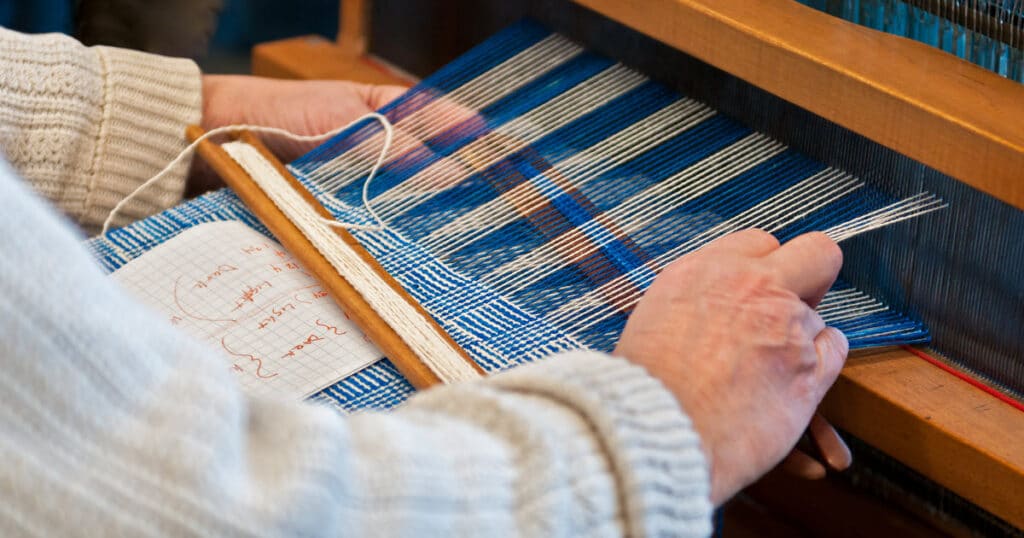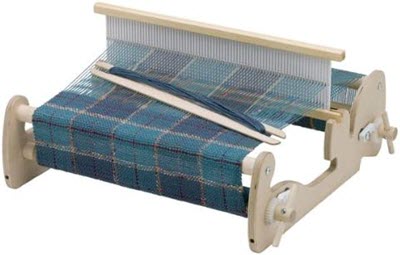Weaving is a traditional way of producing fabric that has been practiced by fiber artists for thousands of years. Woven fabric is made of lines of interlaced yarn arranged in perpendicular directions to each other. It produces a pattern shaped like a cross, and fabric that is very durable and attractive. In today’s article I’ll be exploring everything there is to know about the weaving loom. I’ll list the different types of weaving looms, weaving terminology, the history of weaving, how to weave using a loom, tools, and accessories you’ll need to have in addition to the loom itself and share my tips for selecting the perfect weaving loom for you.
Let’s get right into it!
What is a Weaving Loom? (and why you may need one)
A weaving loom is the piece of equipment that is used for weaving fibers together to make a piece of fabric. You can use a weaving loom to make a rug, a table runner, or a variety of other materials used for garments and decoration. Looms keep the warp (longitudinal) threads where they should be as you weave the weft (or “filling”) threads through them. In the process, a weaver can decide to use different thread or yarn colors to end up with special patterns. Different kinds of patterns or textures can be achieved by altering the method you’re using at your loom.
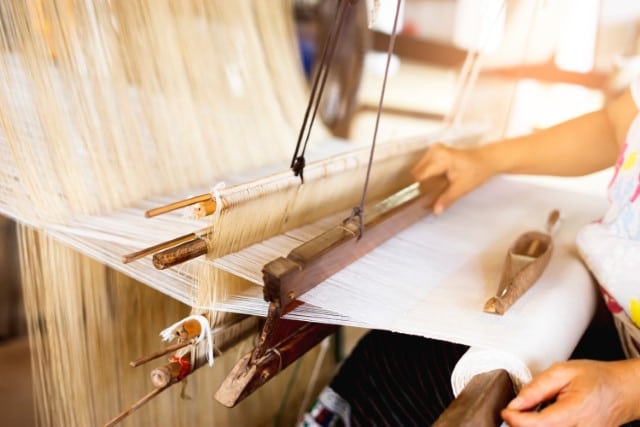
- There is a thread that is positioned going down the fabric that is referred to as the warp. This thread is positioned in a longitudinal direction.
- There is also a lateral thread that goes across the fabric’s width. This is referred to as the weft.
Different Types of Weaving Looms
There are several different kinds of weaving loom available, and the styles I’ll focus on in this article will be:
- Handlooms
- Backstrap Looms
- Tapestry Looms
- Rigid Heddle Looms
- Inkle Looms
- Floor Looms
- Table Looms
- Power Looms
In this section of the guide I’ll go over each type in detail, discussing the advantages and disadvantages of each style of loom to help you determine which type might be the best fit for you.
Hand Loom
A handloom is simply a loom that runs manually instead of with electricity. These looms can come in a variety of forms.
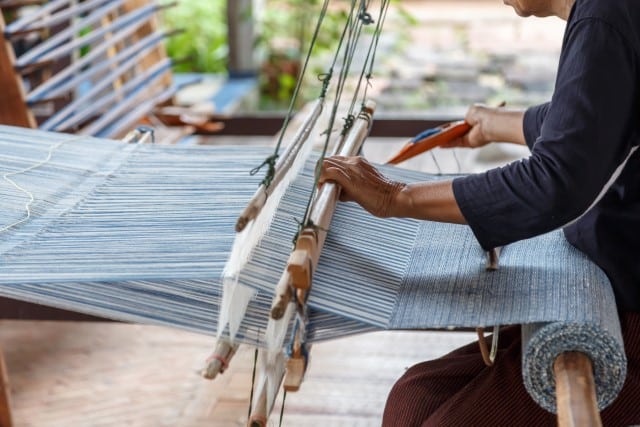
Most handlooms are wooden “vertical shaft” looms. With this kind of loom, the heddles are held in a specific position in the shaft. The movement of the warp threads alternate between going through a space between the heddles (also called the shed) and a heddle.
When you raise the shaft, you raise half of the threads. This half will be the threads going through the heddles. If you lower the shaft, the same threads will lower. Either way, the threads that are passing through “the shed” (the spaces between the heddles) stay where they are. There are different kinds of handloom.
Backstrap Loom
The backstrap loom is an extremely simple type of handloom developed in ancient times. It’s still found and used in several countries today. With a backstrap loom, the warp is tied to the weaver on one end and a stationary object on the opposite.
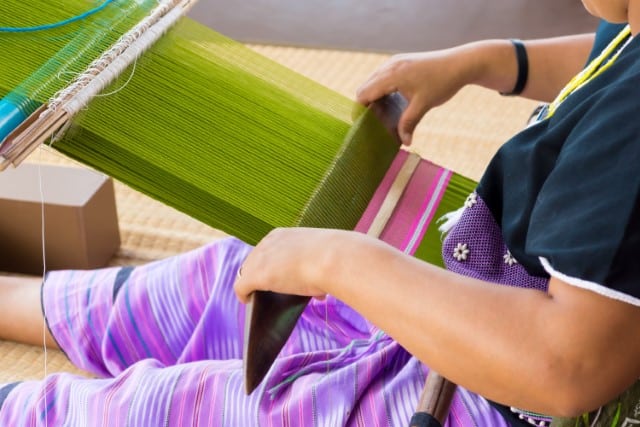
The weaver’s weight is the force keeping the warp properly taut. While it’s true that a backstrap loom is very basic, a skilled weaver is still able to make complex and impressive patterns.
A simple backstrap loom like this one is perfect for beginners and will hardly take up any room at all. Features of this loom include a belt loom, hardwood clamp, and shuttle beater. It also comes with cotton weft yarn and cotton warp.
Advantages:
- Portability
- Simple design that makes it perfect for beginners
Disadvantages:
- Isn’t suited for making polished and consistent weaves
Tapestry Loom
Tapestry looms are frame looms, which are the simplest kind of manual looms. When you use a tapestry loom, the size of the tapestry you create is determined by the frame size. Also, you will not have the ability to create a shed on a frame loom.
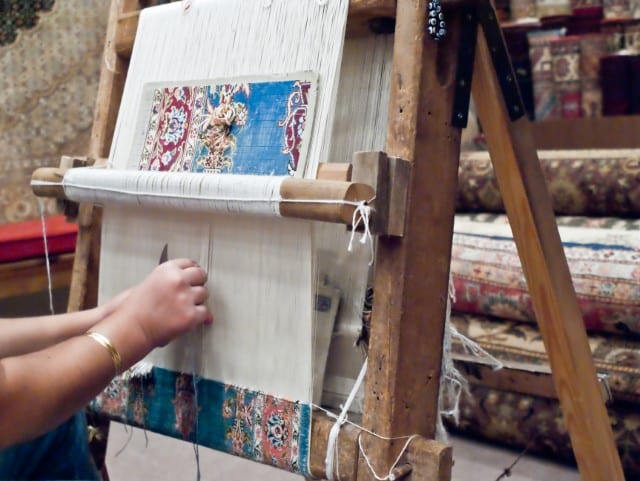
There are some types of tapestry looms that are larger and able to hold longer warps. These also provide ways of creating a shed.
If you’re a true beginner but you really want a tapestry loom, think about the Schacht Tapestry School Loom. Learners of all ages can use this loom. It’s suitable to use on a table or the floor. It is quite compact in size and it comes with a weaving needle, two pick-up sticks, and detailed instructions.
Advantages:
- It’s simple to set the size of your tapestry
Disadvantages:
- You cannot create a shed to help separate the yarns and keep them organized
Rigid Heddle Loom
If you’re a beginner, a rigid heddle loom is a great choice. Even skilled weavers can use this kind of loom to do complex patterning through manual manipulation of the weft and warp.
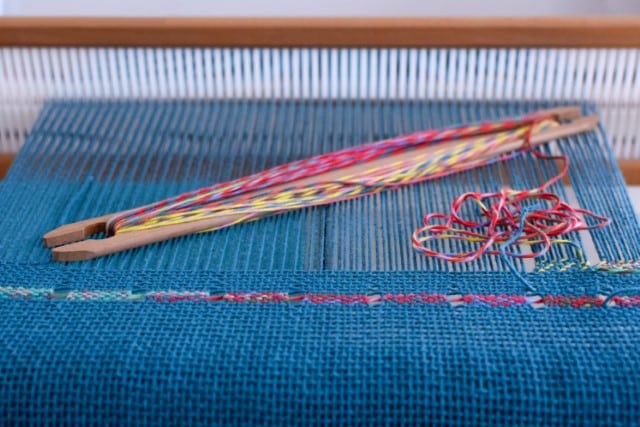
If you have just one rigid heddle, you can use it with thick yarns for two-shaft weaving. If you add an additional heddle, you will be able to use thinner types of yarn and create more sophisticated patterns. To do this, you can use pick-up sticks as well as manual manipulation techniques. An attractive feature of rigid heddle looms is that they are portable. You can use rigid heddle looms with a stand or without.
The Schacht Cricket Rigid Heddle Loom is a great loom for beginners. It comes in a compact size and it can be portable, too. This loom is made of beautiful maple and apple plywood. It is sold unfinished. The Schacht Cricket Rigid Heddle Loom comes with several different accessories, including: table clamps, warping peg, threading hook, 8-dent rigid heddle, two shuttles, and even two yarn balls so you can get started right away.
Advantages:
- Compact and portable
- An excellent choice for beginners
- Can be used for both simple and complex weaving patterns
Disadvantages:
- Doesn’t provide the same kind of tension you would get from a floor loom
Inkle Loom
If you just want to weave thin strips of fabric to create perhaps belts or straps, an inkle loom will be appropriate. This kind of loom is portable. If you are a beginner, an inkle loom might be a good choice for you. In certain contexts, skilled weavers can use inkle looms to make sophisticated patterns.
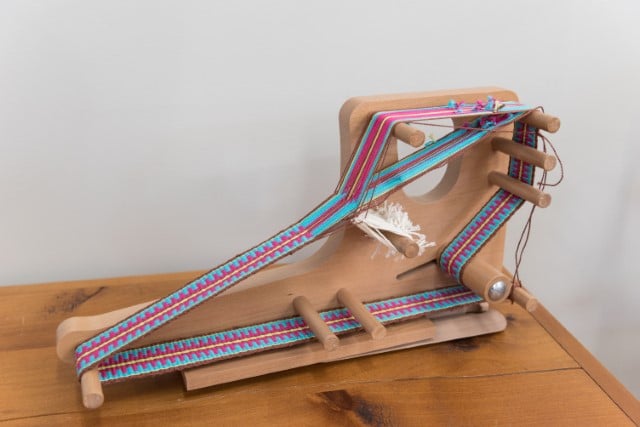
If you want to try an inkle loom, the Ashford Inkle Loom might be the one for you. It is made of unfinished New Zealand Silver Beech. You will be able to produce very durable and long braids with this loom. The loom has an adjustable tension peg, so you can change the warp tension if you want to. The Ashford Inkle Loom is advertised as being especially good for making trims, straps, belts, and bracelets.
Advantages:
- Small and portable
- Can be a good choice for beginners
Disadvantages:
- Limited in the width of weavings it can create
Floor Loom
Floor looms are the largest type of loom used by home weavers. A floor loom is freestanding and you can use it for larger projects.
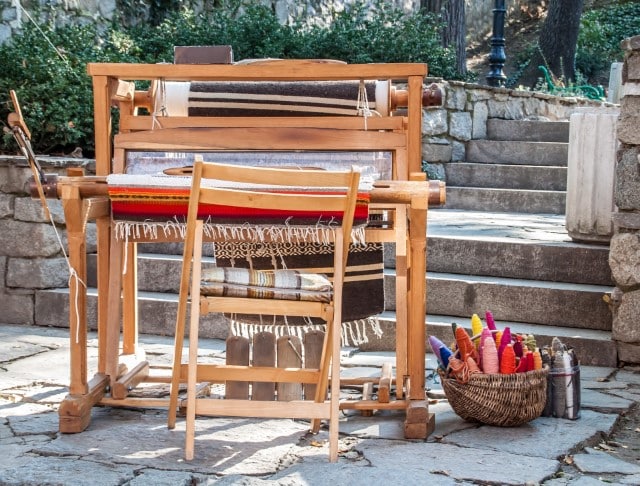
If you want to create wider and longer stretches of fabric, such as you would find with rugs, home linens, and other kinds of home accessories. A floor loom will usually have four or eight shafts but it is possible to find models of this kind of loom that have more shafts.
While a floor loom is a manual loom in most cases, it’s possible to control this kind of loom electronically. This uses a dobby that can lower and lift the harnesses to produce sheds.
A floor loom isn’t usually something that beginners choose. However, if this kind of loom is what you have your heart set on, check out the Leclerc Compact Floor Loom. It’s less expensive than many other floor looms and a bit smaller in size.
Advantages:
- The most powerful and versatile manual loom
- You can make anything on it, even large projects
Disadvantages:
- It takes up a lot of space
- They are expensive
Table Loom
If you’re looking for something smaller and more portable than a floor loom, a table loom can be a good choice. A table loom is more complex than some other small looms.
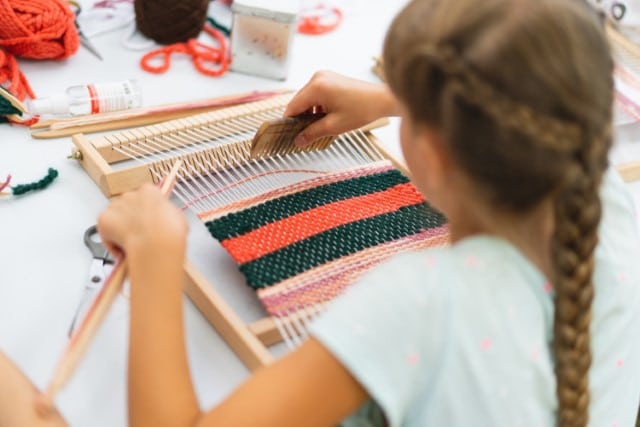
This kind of loom is designed to be used on top of a stand or table. Table looms usually have either four or eight shafts.
There are some types of table loom, though, that have more than eight shafts. Some of the other types of looms that we have discussed above are table looms.
Power Loom
The power loom is a type of mechanized loom. It is powered by a power driven rotating shaft called a line shaft.
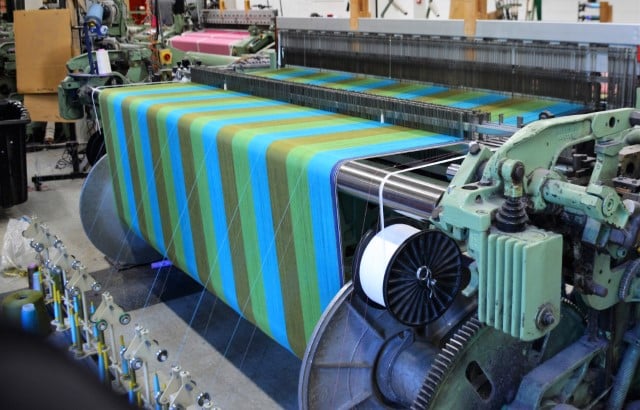
Edmund Cartwright designed the first power loom in 1784. The first one was built in 1785. The next five decades after that saw refinements on the original design. The Lancashire Loom was the design that rendered power looms entirely automatic.
There were more than 250,000 of these used in England by the middle of the nineteenth century. The Northrop Loom emerged fifty years later.
Other Types of Weaving Loom
Many other models have been designed over the decades since then. Let’s take a look at some of the different types below:
Shuttle
The first power looms invented were this type. With shuttle-type looms, there is an unraveling of weft spools while the shuttle moves across the shed. In many ways, this has similarities to projectile ways of weaving.
One way it is different from those is the fact that the spool is kept on the shuttle. Shuttle-type looms are no longer used in manufacturing. That is because these machines are limited when it comes to their efficiency. Their picks-per-minute rate has a maximum of only 300.
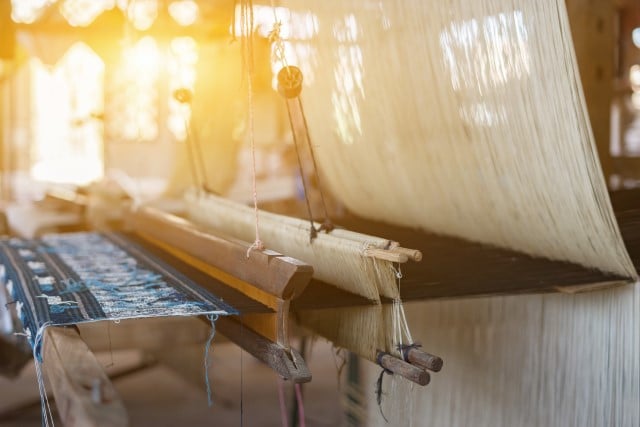
Air Jet
Air jet types of power loom are the most efficient of the traditional weaving methods used in manufacturing. With an air jet loom, compressed air in short bursts moves the weft through the shed.
This is key to creating the weave. Air jet looms can reach as many as 1200 picks-per-minute. These looms are quite expensive because of how complicated the air jet positioning is, as well as the enormous amounts of compressed air you need to operate the machines.
Water Jet
Similar to air jet looms in principle, water jet looms use pressurized water instead of air for weft propulsion.
Water is more inexpensive than compressed air, and this is one reason why water jet machines are popular. The picks-per-minute rate for water jet looms can reach even 1000.
Projectile
Projectile looms use an object that is moved across the shed. Spring power usually propels the object. The object is guided along the cloth’s width by way of a series of reeds.
After that, the projectile is taken out of the weft fiber. It then goes back to the machine’s opposite side so that it can be reused.
Increases to pick speed are created through the use of multiple projectiles. These machines can get to speeds of 1050 ppm.
Rapier Looms
Rapier looms provide excellent versatility. There are different kinds of rapier available. Every type of rapier loom uses a hook system attached to a metal band or rod so that the pick can pass across the shed.
This type of loom can get to a picks-per-minute speed of about 700 in normal manufacturing conditions.
Hand Loom vs Power Loom (what’s best for you?)
Let’s look at the respective pros and cons of handlooms and power looms.
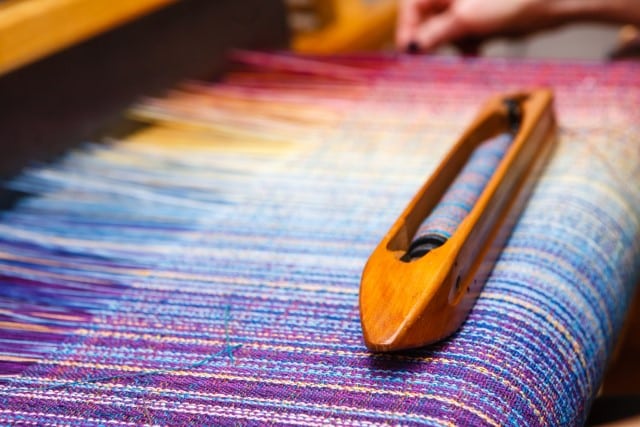
To review, handlooms are looms that must be operated manually. There is no electricity powering them. Power looms use electricity in some form.
| Hand Loom | Power Loom |
|---|---|
| Advantages: Hand looms are manual and don’t require electricity. With a manual loom, you can change to a different weaving pattern very quickly | Advantages: Not as much skill is required with a power loom. After the power loom is set and started, it will work independently. Power looms are much more efficient than a hand loom |
| Disadvantages: Manual labor is necessary to operate a hand loom. They cannot compete with power looms when it comes to production volumes and efficiency. | Disadvantages: After a power loom has been set for a particular design, you cannot easily change it. These looms are much more expensive than other types. Power looms are used for industrial purposes. They are not suitable for use at home. |
History of Weaving Looms
As we touched on earlier, human beings have been weaving for thousands of years. In fact, weaving is the oldest form of textile production. Both vertical and horizontal looms were used in Europe, Africa, and Asia by 700 AD. Around this time, pit-treadle looms equipped with pedals were developed and they began to be found in Iran, Syria, and Islamic regions of East Africa.
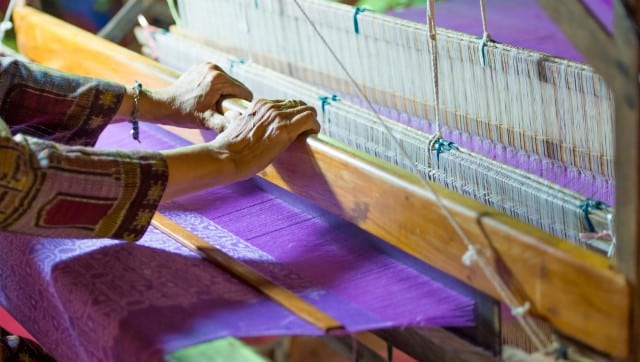
Later on, looms advanced so the weaver had a free hand to pass the shuttle while using the foot for heddle operation. It was the most often used loom in Medieval Europe. Home weaving became extremely common in Europe.
Eventually, factors such as plague, war, and famine caused most weaving to move to centralized places rather than individual homes. The advent of power looms in the Industrial Revolution transformed weaving and the fabric production industry.
Wool Yarns to Use in Weaving
To weave with wool, you will need to have the appropriate width of wool for your project. While thicker yarns lend to quicker weaving, you should be aware that they will make your warp thread show. For tighter weaves that won’t show the warp, you should use worsted weight yarn or DK.
Yarn that you use for weaving must be strong enough to withstand the warp. The pinch and pull test helps you determine if this is the case.
Wind some of the yarn around the index and middle fingers of your right hand. Prop it against your thumb, and then grab onto the end with your left hand, wrapping it around that hand and then pulling the yarn as hard as you can.
If the yarn doesn’t break, it should be strong enough for weaving.
Weaving Terminology
Just for the sake of clarity, here are the definitions of some common weaving terminology.
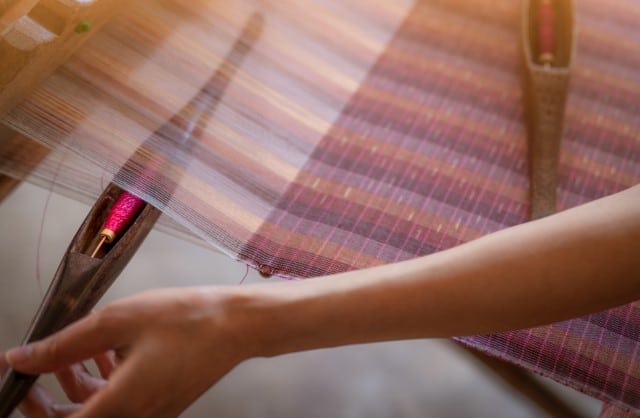
- Weft: The weft is the thread that you will weave between the warp threads. This is a necessary part of creating cloth.
- Warp: The warp is the thread that moves from the front of the loom to the back. This thread is woven into when creating cloth.
- Warp separators: Warp separators are generally warp sticks (or perhaps pieces of heavyweight paper) that are inserted to separate layers of warp. It maintains distance between the layers of warp on the beam. Warp separators are useful for keeping proper tension during the weaving process.
- Shed: The shed is an opening separating warp threads made by lowering or raising the heddle. During weaving, the shuttle moves through the shed.
- Header: A header is the yarn woven within the first three inches of the warp. It helps evenly spread the warp threads prior to weaving.
The Process of Weaving Using a Loom
The exact process of weaving will depend on the kind of loom that you have. In this section, we will go over some of the basic steps of weaving on a simple handloom.
- Dress the loom with warp. Ensure that it stays taut.
- Prepare a shuttle that will let you wave the weft through the warp.
- Prepare a shed stick. This tool lets you create a weave between the threads of warp. You’ll be able to put the weft through the openings created by this.
- Weave the shed stick through the yarn, first going over, then under and continuing that process until the end. After you’ve done this, the shed stick can move backward and forwards.
- If you like, you can also use a spacer.
- Add another shed stick, this time starting with going under and over the yarns.
- If you added a spacer for the other shed stick, add a second one.
- Use a loom comb (also called a beater) to ensure the weft is positioned properly and correct your yarn density.
- Begin weaving by using the shuttle and weft.
How to Select the Right Kind of Loom for You
There are several factors you need to consider when deciding what kind of loom is best for you.
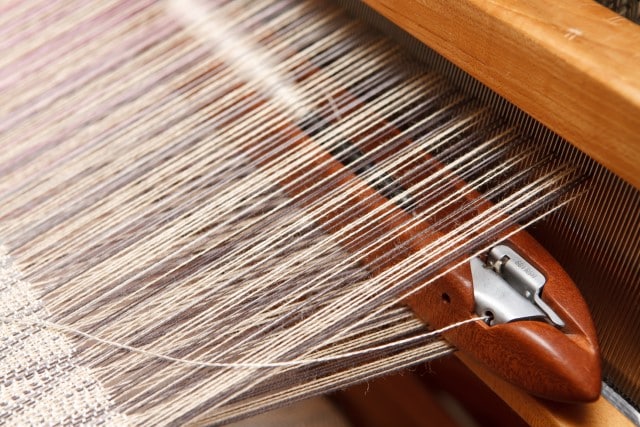
Some of these include:
- Your knowledge and expertise as a weaver
- Cost and budget
- Space requirements
- General preferences
If you are a beginner weaver, you won’t want to buy an extremely expensive floor loom that costs thousands of dollars and you might not have the space for. As a beginner, you are much better off buying a small loom, such as a rigid heddle loom, an inkle loom, or a backstrap loom.
Important Tools and Accessories Beyond the Loom that a Weaver Will Need
Other than a loom, what are the other important tools and accessories that you will need for weaving? Let’s take a look below.
Warp yarn
Different kinds of yarn can be used as warp yarn, but cotton yarn is the most popular. Whatever yarn you use, make sure that it is durable and able to deal with the stress of weaving. The specific warp yarn you use will also depend on the specific project.
Weaving yarn
Weaving yarn is also called weft yarn. You have a lot more latitude in what you can use as weaving yarn than you can with warp yarn. That is because with the warp yarn, you have to worry more about strength and durability. With the weaving yarn, you may be able to use thinner yarns and think more about appearance than other qualities.
Tapestry needle
A tapestry needle is a blunt needle. It weaves yarn through the warp in a meticulous way that won’t damage any of the yarns.
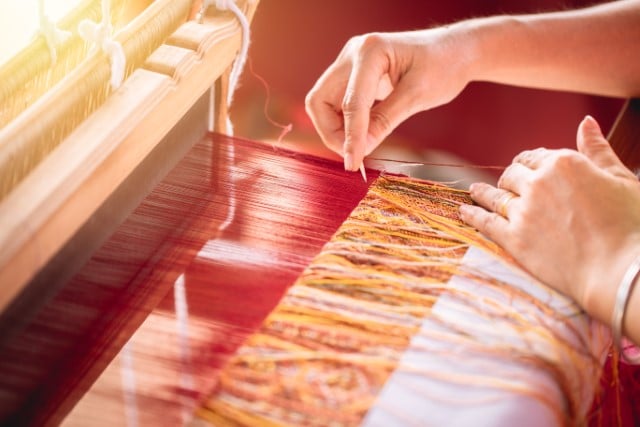
Most tapestry needles are plastic or metal. Wood tapestry needles have recently become available.
Loom comb
You need to use a loom comb to control yarn density. It does this by beating down the yarns that you have on the loom.
Shed stick
A shed stick makes the weaving process easier by making an opening to separate the warp layers. This makes it easier for you to get the weaving yarns through the warp. Most shed sticks are made of smooth and flat wood. The size is usually similar to a ruler. The warp width is important when deciding on the length of the shed stick. It should be about an inch or two longer than the warp yarns.
Shuttle or Yarn Bobbin
Wrapping weft yarn around a shuttle or yarn bobbin makes it easy to keep them where they should be during the weaving process.
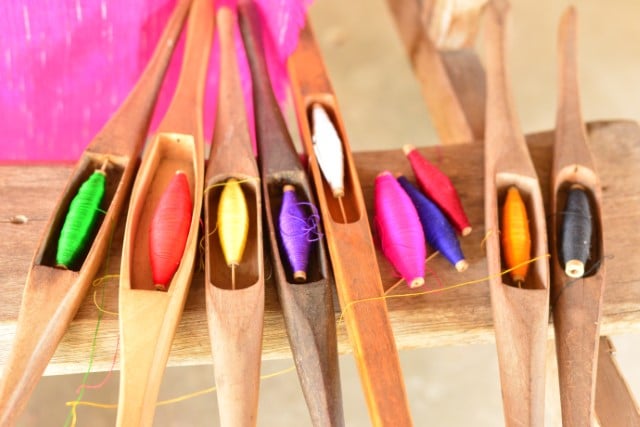
You can find yarn bobbins in different sizes and made of different materials.
Measuring Tool
Have a tape measure or ruler on hand for measuring. You need to keep track of the weaving edges and width.
Shears or Scissors
You will always need a cutting tool such as shears or scissors when you are weaving. This is because sometimes you have to cut the weft and warp yarns. You should find regular hobby scissors are good enough for this purpose.
Are You Ready to Start Weaving?
Now you’ve learned about weaving looms, the weaving process, and the materials you will need to weave, are you ready to start your new hobby?
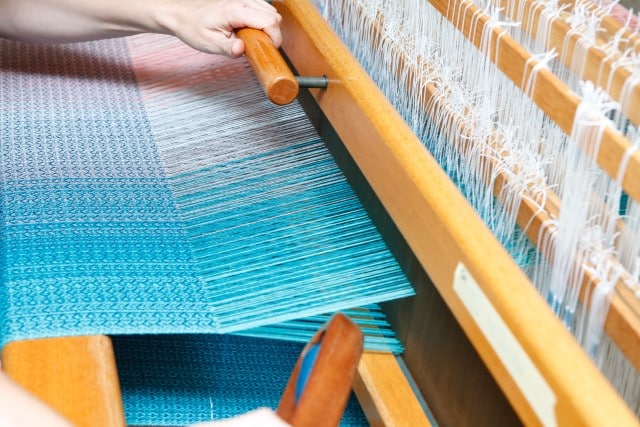
Keep all of these tips in mind and take things one step at a time.

